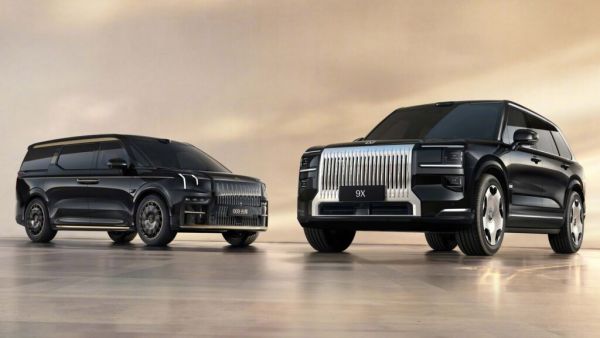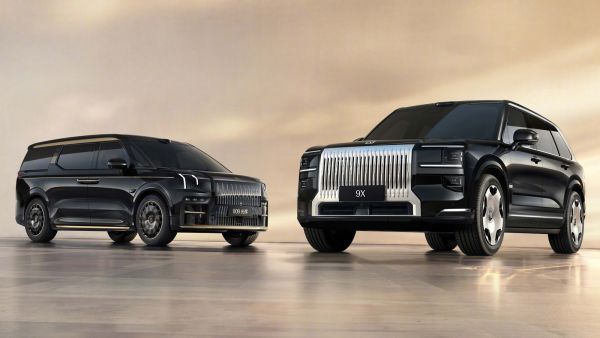While not exactly a well-known name in much of the West, the Geely Group, a member of Zhejiang Geely Holding, operates like the rough equivalent of General Motors for the Chinese Market. In other words, Zhejiang Geely Holding, or simply ZGH, functions as an umbrella for several manufacturers, each with their own unique history and specialization.
It’s a fairly new group as far as the automotive sector goes; it was founded in 1986 as a refrigerator parts manufacturer by Chinese entrepreneur Eric Li, AKA Ki Shufu, effectively working out of shacks by most car manufacturers’ standards. In 1994, the nascent company expanded into the motorcycle industry, producing motorized scooters out of its location in Zhejiang Province, China. The Geely Group was established two years later to consolidate these industries under one banner, the name “Geely” meaning “Auspicious” in Mandarin, and entered the automotive sector in 1997. The company officially became the first privately-owned carmaker in China in 2001, and has since ballooned into the international scene with multiple manufacturers under its envelope.
These represent the lion’s share of Geely’s worldwide presence, with one bizarre automaker to cap it all off. ZGH is one of the several conglomerates with shares and interests in some of the world’s top car brands, with ZGH’s being Smart, Lotus, Volvo, and its subsidiary Polestar, among several others. However, as for indigenous Chinese marques, Geely stands near-peerless, becoming a popular international player in less than two decades. Let’s check out the most well-regarded manufacturers under its umbrella in both the Chinese and foreign markets and see what each brings to the table.
Geely Auto
First and foremost is the eponymous Geely Auto itself. While it built a prototype fake Mercedes based on an Audi 100 chassis in 1996, Geely produced its first actual production model in 1998: the Haoqing, shortened to “HQ.” These were barebones subcompacts with complicated numerical designations and multiple body styles, but ultimately the car was simply a Chinese copy of the second-generation Daihatsu Charade built for their domestic market. In fact, it’d be more accurate to say that the original Geely HQ was a copy of a copy, because it was based on a proposed Tianjin Xiali station wagon. Daihatsu partnered with the Tianjin Automotive Research Co. to produce these cars under license, then when production fell through, Geely Auto picked up the slack, copying Tianjin’s and Daihatsu’s designs.
It was a bizarre and inauspicious start to the company, but in just four years after debuting the HQ, it became one of China’s top 10 automotive brands. The early brand became synonymous with “good enough” cars, mostly copies of foreign designs. However, Geely has since branched out to mid-range compacts with the Geely Emgrand, which performed well in the export market.
Now, Geely offers a full range of cars from the Emgrand compact to crossovers and SUVs, generally aiming at the mid-price luxury bracket similar to brands like 1990s-era Lexus. Geely even created futuristic concepts like the Geely Galaxy EV. Their current vehicles utilize technology and design elements borrowed from Volvo, which the ZHG umbrella currently owns. As mentioned before, ZHG is the greater Geely Group, representing Stellantis with Dodge and Fiat under its banner, for example.
Proton/Lotus
Proton Cars is a Malaysian car company dating back to 1979, marketed as Malaysia’s first national automotive brand with the first national car: the 1985 Proton Saga. A copy of the second-gen Mitsubishi Lancer Fiore, the Saga became the backbone of Proton as a company, representing its longest-lasting and best-selling car. Proton launched variations of the Saga, ultimately securing a 64% market share of Malaysia’s automobiles. By the 1990s, the company sought expansion into automotive parts and export markets, acquiring an 80% stake in Lotus in 1996. And that’s why Geely owns Lotus today; Geely acquired Proton in 2017, which at the time had owned Lotus for 21 years.
The Proton Saga remains in production today, representing the company’s entry-level option, though the range has since expanded to the X50, X70, and X90 SUVs respectively, with each SUV growing larger and better-appointed with the number value. Much like Geely Auto’s variant, these SUVs share many similarities with Volvo’s lineup, likely a byproduct of Geely’s co-development in the various platforms used by current Volvo models.
As for Lotus, that brand has its own rich and storied history dating back to 1948. Proton as a company wasn’t doing particularly well on the international market, but Lotus was a prestigious name. Consequently, it represented arguably the main reason why Geely purchased Proton, not for Proton Cars itself. Today, Lotus retains a loyal fan base of enthusiasts of lightweight British sports cars. Though, the company has since departed from these well-established motorsports roots, stirring recent controversy with vehicles like the Lotus Eletre crossover EV.
Lynk & Co.
Lynk & Co. is another Swedish automotive company, though a far more recent example than Volvo. Regarded as the first company to send a text message from an orbiting satellite, Lynk was founded in 2016 as a three-way joint venture between Volvo, Geely Auto Group, and Geely Holding, and is co-owned by Geely Auto. Effectively, Lynk is a startup company which promotes its vehicles to a younger demographic, designed from the outset with a subscription-based model and direct-to-consumer sales. An example of this appeal is in the name: “Lynk” supposedly refers to interconnected cars, while the “& Co.” portion is, by the company’s own admission, meaningless filler to create a “younger vibe” similar to companies like Abercrombie & Fitch.
Much like Geely’s other holdings, Lynk’s vehicles share basic architecture with Volvo. Its models bear simple numerical designations, from ’01 to ’03, with the first model being a beefier Volvo XC40. Each car features radically-different front and rear architecture, its signature look accomplished with a large wraparound grille and headlights mounted above the wheel arch line.
They also provide respectable performance, with the ’03 sedan producing 215 horsepowerand a 0-62 time of 7.2 seconds. The ’01 also demonstrates improved performance figures, up to 276 horsepower from a basic crossover. It’s not exactly Earth-shattering levels of performance, but that’s part of its appeal; without exorbitant performance levels, these cars are produced at far more reasonable prices in comparison to top-level EVs. For instance, a 2024 Lynk 01 is only about $21,500 to $27,000 new for a base-model to high-trim, respectively; less than half that of the average 2024-model EV price in North America.
Zeekr
Zeekr represents Geely’s premiere all-EV brand, focused more on the high-end luxury market. Launched in 2021, the company remains in its adolescence, though it currently fields a number of unique oddballs. Take the Zeekr 009, for example: a full-size luxury electric MPV with a front end resembling that of a Rolls-Royce Spectre. Not to mention that this thing rockets to 62 mph in just 4.5 seconds and boasts the world’s first 140 kWh battery fitted to a production car, making it one of the most powerful minivans ever built. Likewise, Zeekr markets the 001, its inaugural model, as a four-door shooting-brake, a term not used to describe any sort of “trendy” car in decades — though it remains effectively a crossover with a different name.
The company built its very foundation as an EV firm, similar to Tesla, even incorporating its roots into the name. Zeekr stands for “ZEro-Emission-KRypton,” with krypton being the element, not Superman’s home world. Despite the odd-sounding name, the cars themselves tout excellent performance figures and luxury features to boot, with the Zeekr 007 the fastest of the lot with comparable specs to a Porsche Panamera Turbo S E-Hybrid at unquestionably a lower price. Being a fairly new player in the EV game, however, Zeekr’s new platforms are entering a competitive market within the luxury space, whereas niches like basic, inexpensive EVs from Lynk & Co. pose more potential for mass-market appeal. Nevertheless, if you want something that’ll blow a 2000s sports car’s doors off while maintaining the proportions of a lowered Ford Transit van, Zeekr has a car for that.
London Electric Vehicle Company (LEVC)
This one comes straight out of nowhere. London’s iconic Black Cabs utilize a design dating back to 1958, namely the Austin FX4, forming the basis of the modern TX4 Black Cab still found all over the city. The final combustion-powered London cab design was approved in 2008, based on a Mercedes-Benz Vito. However, in 2017, Transport for London — the company that dispatches Black Cabs, similar to New York’s Taxi and Limousine Commission that owns Yellow Cab — declared that all of London’s new Black Cabs must be zero-emission capable.
Enter the London Electric Vehicle Company, or LEVC: a company dedicated to producing British-designed passenger service vehicles for British roads. It took exactly one year for LEVC to debut its inaugural model, and to no one’s surprise, it was an electric London taxicab. Since its debut, the LEVC TX, as it’s known, clocked more than 1 billion miles and prevented over 200,000 tons of emissions. So how did such an iconic vehicle come under the ownership of a Chinese firm?
Geely rescued the London Taxi Company from insolvency in 2013 in-part due to the rise of Uber and subsequent protests by London’s traditional taxi firms. The firm that assembled the ubiquitous Black Cab, under the ownership of Manganese Bronze, traded hands for just $17 million USD, securing the future of the London taxicab. With the resources of the multi-billion net worth Chinese firm behind it, the London Taxi Company rebranded as LEVC in 2017, and restarted production of its current all-electric lineup. Most recently, the company announced its 2024 Model 380, a luxury-oriented MPV catering to high-market private owners and likely a host of shuttle services.





